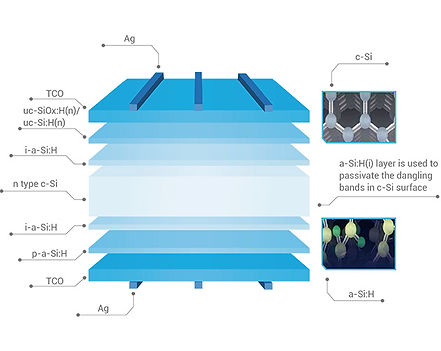HJT Technology
Introducing HJT

What Are the Advantages?
High Conversion Efficiency
HJT solar cells use amorphous silicon (a-Si) thin films as passivation layers to reduce carrier recombination, which can increase the open circuit voltage to 750 mV and boost the efficiency to 24% already in the beginning.
High Bifaciality
HJT solar modules have a high bifaciality of up to 97%, due to their natural bifacial symmetrical structure. This means that they can generate electricity from both the front and back sides, resulting in energy yield gains of up to 30% in some cases.
Low Temperature Coefficient
HJT solar cells are made from n-type wafers, which do not have boron-oxygen (B-O) bonds, resulting in no light-induced degradation (LID). Additionally, the transparent conductive oxide (TCO) film on HJT solar cells is conductive, which prevents charge polarization on the surface and avoids potential-induced degradation (PID)
Long Lifespan
The unique design and construction of HJT solar modules make them more durable and long-lasting than other types of solar modules. As a result, HJT solar modules are expected to have a lifespan of over 30 years.
Better Weak Light Performance
N-type solar cells have a longer minority carrier lifetime than bifacial PERC solar cells, which results in better power generation under weak light. N-type solar cells can generate about 0.5% to 1% more power per watt than bifacial PERC solar cells under weak light conditions.
Ultra Low Carbon Footprint
HJT solar cells have a lower carbon footprint (less than 400g CO2/W) than other types of solar cells, such as PERC (more than 700g CO2/W), due to a number of factors, including fewer processing steps, less energy requirements, thinner wafers, and higher efficiency.
The Future of HJT
